- News
- Reviews
- Bikes
- Components
- Bar tape & grips
- Bottom brackets
- Brake & gear cables
- Brake & STI levers
- Brake pads & spares
- Brakes
- Cassettes & freewheels
- Chains
- Chainsets & chainrings
- Derailleurs - front
- Derailleurs - rear
- Forks
- Gear levers & shifters
- Groupsets
- Handlebars & extensions
- Headsets
- Hubs
- Inner tubes
- Pedals
- Quick releases & skewers
- Saddles
- Seatposts
- Stems
- Wheels
- Tyres
- Tubeless valves
- Accessories
- Accessories - misc
- Computer mounts
- Bags
- Bar ends
- Bike bags & cases
- Bottle cages
- Bottles
- Cameras
- Car racks
- Child seats
- Computers
- Glasses
- GPS units
- Helmets
- Lights - front
- Lights - rear
- Lights - sets
- Locks
- Mirrors
- Mudguards
- Racks
- Pumps & CO2 inflators
- Puncture kits
- Reflectives
- Smart watches
- Stands and racks
- Trailers
- Clothing
- Health, fitness and nutrition
- Tools and workshop
- Miscellaneous
- Buyers Guides
- Features
- Forum
- Recommends
- Podcast
review
£4,909.00
VERDICT:
Phenomenal speed, phenomenal handling, phenomenal looking, could do with a little bit of character though.
Weight:
7,000g
Contact:
www.storck-bicycle.cc
At road.cc every product is thoroughly tested for as long as it takes to get a proper insight into how well it works. Our reviewers are experienced cyclists that we trust to be objective. While we strive to ensure that opinions expressed are backed up by facts, reviews are by their nature an informed opinion, not a definitive verdict. We don't intentionally try to break anything (except locks) but we do try to look for weak points in any design. The overall score is not just an average of the other scores: it reflects both a product's function and value – with value determined by how a product compares with items of similar spec, quality, and price.
What the road.cc scores meanGood scores are more common than bad, because fortunately good products are more common than bad.
- Exceptional
- Excellent
- Very Good
- Good
- Quite good
- Average
- Not so good
- Poor
- Bad
- Appalling
Fast, light and deeply purposeful, the Storck Fenomalist is a high-speed blast. But is it so efficient that it ends up a bike bland?
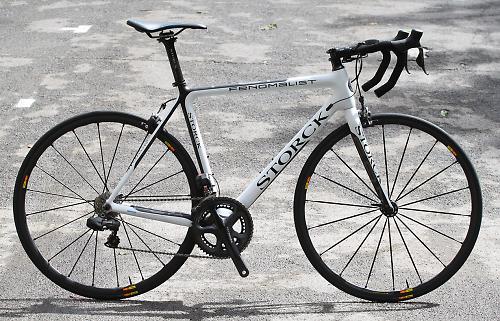
While retro seems to be en vogue at the moment with steel and even aluminium making a comeback it's good to see things are still moving forward. The likes of Colnago and Bianchi trade on years of tradition and history but German company Storck take a more engineered route, or 'form follows function' as they like to put it to create what are quite often regarded as some of the best race bikes on the market. This is the first Storck frame to arrive at road.cc and it's a good 'un.
Frame & Fork
Looking through various brochures and blurb it's obvious that Storck takes stiffness to weight ratio very seriously. To achieve the same figures regardless of frame size they use Proportional Tubing. What that means is rather than just extend the tube to make a bigger frame Storck alter things like wall thicknesses and carbon lay-up to achieve the desired result. The front triangle and seat stays get this treatment while the bottom bracket and chainstays are standard across the range.
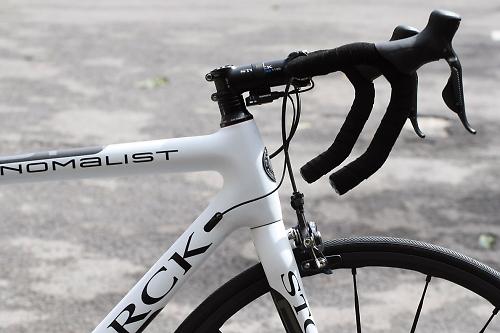
It's costly with regards to tooling and moulds but looking at the Fenomalist's CV of test results and accolades it's obviously something that's worth doing.
For a frame that claims such high stiffness figures the tubes are surprisingly slender. You can see areas of oversizing at the head tube and BB but on the whole it's got a rather traditional look about it. A lot of designers have gone down the tapered head tube route in the search for front end stiffness and on the bikes we've tested there has always been a noticeable benefit but surprisingly Storck have decided to stay with 1 1/8in top and bottom. What they have done though is reinforced the headset section creating a rather bulbous head tube.
The rear-facing carbon fibre dropouts are reinforced as well. It takes a bit of getting your head round when it comes to changing wheels but you quickly learn.
This Generation 2 (G2) frameset has been updated to use BB86 press fit bearing cups, the 86 referring to the shell width in mm, up from the standard 68. The wider shell adds to that all important stiffness score and allows more material to be positioned at the chainstay/BB junction.
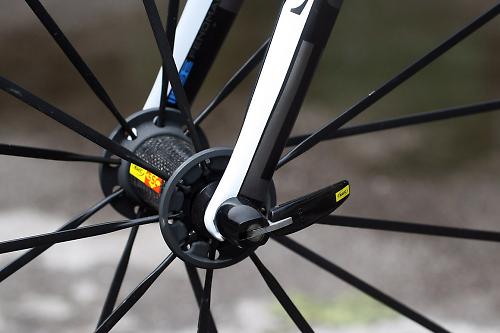
The G2 is also, as with all of Storck's 2013 road machines, compatible with both electronic and mechanical shifting and whether you're using cables or wires they travel internally through the frame.
Geometry wise there is no doubt that the Fenomalist is destined for racing. Our 55cm test bike has steep 73.5° seat and head angles for power transfer and quick steering while the effective top tube length is a stretched out 56.6cm. Pair this up with a short 139mm head tube and it leaves you with a stack height of 552mm and reach measurement of 403mm.
There are six sizes available from 47 – 63cm and the newly assigned distributor in the UK, Storck Raddar UK Ltd make it a requirement that stockists have to provide a full bike fit to make sure it fits the customer and works in line with their riding style.
This will be achievable by the fact that Storck Raddar UK are supplying 30-40 'bricks and mortar' shops around the country.
Up front the Fenomalist uses Storck's own Stiletto 300 carbon fork, so named due to the weight being around the 300g mark. Its got a reputation as being a bit on the flexible side due to those narrow legs but we'll wait and see. It's a full uni-directional carbon fibre construction with carbon dropouts.

The frameset costs £2799 which is pretty fair for the quality and all in weight of around 1200g, that proportional tubing and hand lay-up brings a premium cost to.
Kit
Storck don't just build bikes, components are fair game too and the slightly unorthodox shaped bars are one of their designs. Carbon fibre with a kind of pistol grip they won't appeal to the traditionalists but I doubt Storck will be bothered; their ethos has always been towards performance and engineering over aesthetics.

The stem is also Storck branded as are the carbon fibre seatpost and Storck branded saddle manufactured by Prologo.
Shimano's second tier electronic groupset, Ultegra Di2 adorns the frame which is fitted with a man size 53/39 chainset. The cable for the rear mech pops out of the dropout just above the unit while the battery is now internal meaning the whole electronic theme suits the bike with minimal clutter.
The wheels are Mavic's Ksyrium SLR's with matching Mavic tyres. I first tested these on the Fondriest TFZero and they quite literally blew me away thanks to their performance and braking capabilities. These latest versions have a new coating on the braking surface, Exalith 2 which still squeals as badly as the first version while the first set of pads beds everything in. A claimed weight of 1410g for the pair means they are also the lightest Ksyriums ever.
This little lot will set you back £4,909 for a build that's a good all-rounder that weighs 7.0kg (15.7lb). There are Shimano or Campagnolo options starting off with 105 at £3,495 and topping out at £7,729 for Super Record EPS.
Ride
Speed, speed and more speed: that pretty much sums up the Fenomalist. From a standing start acceleration is impressive thanks to those lightweight Ksyriums spinning up effortlessly but the real magic comes from a rolling start. From the saddle a stab at the pedals sees the bike surge forward, next gear, another surge and again and again it continues until you're easily hitting 30mph on the flat with very little input needed to keep it there.
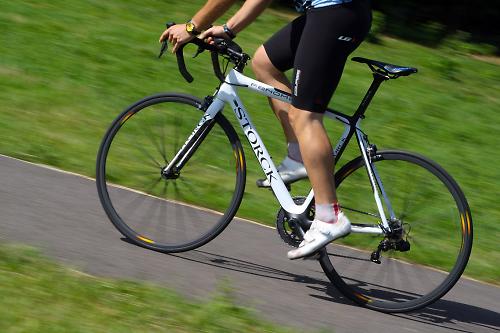
The long top tube and short headtube allowed me to get a perfectly flat back that practically mirrored my time trial bike. The 73.5° seat angle was spot on for aerodynamics without restricting power output and kept the adrenaline giggles coming on a well used test route as I'd go barrelling into a corner way quicker than normal.
The Storck bars, once tweaked and the hoods repositioned were a perfect shape with the 45° section providing a perfect angle for the wrists to keep the lower arms flat.
Descending brought the biggest grins thanks to the composure of the frame as you pick up speed. In the drops the lower centre of gravity and tight frame means it tracks exactly where you want it to. The weight distribution in the stretched out position felt pretty spot on to with even rough sections of tarmac unable to upset things. The front end is very tight which responds well to counter steering and a change of body position should you get too close to the limits.
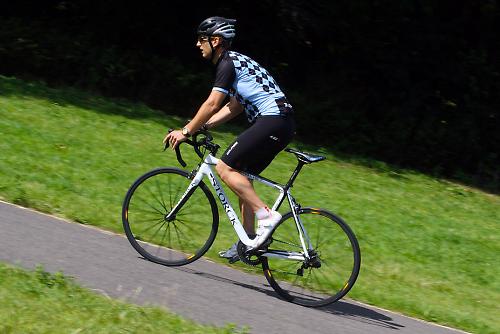
When you first notice the flex at the skinny dropouts of the fork it can become a bit unnerving but it has little overall bearing on the handling or performance. In fact its more the opposite as it works as kind of a suspension ironing out road imperfections.
The Mavic tyres, Griplink front and Powerlink at the rear grip so well and you can really bank them over to stupid angles without them breaking away. On the subject of braking the Exalith coating still does the business when paired with a stiff set of callipers like the Ultegras allowing you to start braking much, much later than with standard alloy rims. As I mentioned above they squeal like hell for the first couple of hundred miles as things bed in but the pads seem to be lasting loads longer than the originals.
The low revolving weight of the wheels and all in bike weight of 7.0kg means climbing is just as much fun as descending. Stiffness around the bottom bracket area means there is no frame flex to speak of and the Ksyriums showed no signs of flexing under load either.
If you're not too flexible though that long top tube could provide some back issues on long climbs unless you spend lots of time out of the saddle. To be fair, Storck UK's requirement that the bike is properly fitted should alleviate that concern.
A lot of people still aren't sure about the whole electronic shifting idea but when you live with it for a few weeks you realise it is the way forward, especially on performance bikes. The quicker shift works well with bikes like the Storck that are all about efficiency and the whole bike just looks cleaner especially now that you can hide the battery. No missed shifts and easy changes from the drops for the chainrings plus the fact that you can shift up the entire cassette with one press means you won't get caught in the wrong gear.

The carbon bars allow a bit of flex which takes the sting out after long hours in the saddle. Handling isn't effected though thanks to the stiffness of the alloy stem.
Prologo saddles always take a fair bit of breaking in and this one was no different feeling pretty harsh throughout the entire test period. It wasn't uncomfortable though just stiff, the carbon post underneath taking care of the vibration.
Value
Just under five grand is a lot of money for a bike but in Storck's defence the Fenomalist is worth every penny. The only other bike I've ridden that has the same sense of speed and acceleration was the Fondriest TFZero and that came in at £7.5k with similar finishing kit and using Super Record mechanical. The niche market that Storck have created for themselves should also see resale values remain high should you ever feel the need to upgrade.
Overall
On the whole the ride is very rewarding and in terms of performance the Fenomalist is just downright amazing. The funny thing is though a lot of the time the Storck doesn't feel exceptionally fast, it feels quick yeah but its not until you catch a glimpse of your Garmin that you realise that you've just flown through that village above the speed limit.
The handling is top drawer with huge amounts of confidence provided thanks to the poise and grounded feeling of the frame. Thankfully all that stiffness doesn't transfer into an uncomfortable ride. Its not what you'd call plush but its perfectly comfortable in keeping with its racing intentions.
The Fenomalist always wants to be pushed though, to be ridden hard; it's not the type of bike you can just go out for a pootle on. My only criticism, and it is a small one, is that it lacks any kind of personality, any soul.
The Storck is a point and shoot bike, where performance is the be all and end all. There is feedback in terms of grip and what the bike is doing beneath you but its very muted and clinical. It's a tool of the trade very much like the Raleigh Militis we tested a couple of months ago and while I absolutely loved riding it its not the type of bike I could live with day in day out. I like a bit of character.
Verdict
Phenomenal speed, phenomenal handling, phenomenal looking, could do with a little bit of character though.
road.cc test report
Make and model: Storck Fenomalist
Size tested: 55cm
About the bike
State the frame and fork material and method of construction. List the components used to build up the bike.
Frame: UD Carbon fibre
Fork: UD Carbon Fibre
Groupset: Ultegra Di2
Wheels/Tyres: Mavic Ksyrium SLR, Mavic Prolink/Griplink tyres
Bars: Storck carbon
Stem: Storck alloy
Seatpost: Storck carbon 31.6mm dia
Saddle: Prologo
Tell us what the bike is for, and who it's aimed at. What do the manufacturers say about it? How does that compare to your own feelings about the bike?
Storck bikes are all about performance, especially power to weight and the Fenomalist is no different. Storck say that it is designed for speed, stiffness, handling yet comfortable. It does do all these things, well the comfort is borderline but it is a bit clinical because of it.
Frame and fork
Overall rating for frame and fork
9/10
Tell us about the build quality and finish of the frame and fork?
Very well finished and a classy looking design. For all of its modern engineering cues it is actually quite tradtional looking. The matt white paint is a nightmare to keep clean though.
Tell us about the materials used in the frame and fork?
The carbon fibre frame uses sections of proportional tubing meaning that each size has varying lay ups and wall thicknesses so that the stiffness to weight ratio is exactly the same as the others. The fork is a monocoque of UD carbon fibre.
Tell us about the geometry of the frame and fork?
A low and long geometry with steep angles for aerodynamics and handling.
The full geometry table is here http://www.storck-bicycle.cc/road-bikes/fenomalist-2014
How was the bike in terms of height and reach? How did it compare to other bikes of the same stated size?
A longer top tube than the norm but creates a perfect position for racing.
Riding the bike
Was the bike comfortable to ride? Tell us how you felt about the ride quality.
It wasn't uncomfortable, it ironed out a lot of the bumps but its all very clinical.
Did the bike feel stiff in the right places? Did any part of the bike feel too stiff or too flexible?
stiffness is bang on, nothing is being wasted.
How did the bike transfer power? Did it feel efficient?
Very efficiently.
Was there any toe-clip overlap with the front wheel? If so, was it a problem?
No.
How would you describe the steering? Was it lively, neutral or unresponsive? Lively but easily controllable.
Tell us some more about the handling. How did the bike feel overall? Did it do particular things well or badly?
The handling was great, very planted nad stable. Rider position, centre of gravity and the like all come together to create a very direct handling machine.
Which components had the most effect (good or bad) on the bike's comfort? would you recommend any changes?
The small flex in the bars and fork create a bit of respite at the front from poor road surfaces. The saddle took some breaking in.
Which components had the most effect (good or bad) on the bike's stiffness? would you recommend any changes?
The wheels are very stiff considering their light weight and the wider axle at the BB means no signs of any flex there.
Which components had the most effect (good or bad) on the bike's efficiency? would you recommend any changes?
Again the wheels low weight mean they spin up very quickly indeed. Di2 is great for quick gear shifting.
Rate the bike for efficiency of power transfer:
9/10
Rate the bike for acceleration:
9/10
Rate the bike for sprinting:
8/10
Seemed to respond better when in the saddle than out
Rate the bike for high speed stability:
9/10
Rate the bike for cruising speed stability:
9/10
Rate the bike for low speed stability:
9/10
Rate the bike for flat cornering:
9/10
Rate the bike for cornering on descents:
10/10
Rate the bike for climbing:
9/10
The drivetrain
Rate the drivetrain for performance:
9/10
Rate the drivetrain for durability:
8/10
Rate the drivetrain for weight:
8/10
Rate the drivetrain for value:
8/10
Tell us some more about the drivetrain. Anything you particularly did or didn't like? Any components which didn't work well together?
Di2 is brilliant, it gets more refined with each incarnation and just makes riding easier. The inclusion of the internal battery cleans the frame up so much as well. The rest of the Ultegra kit works faultlessly and there are only minute differences between this and Dura Ace in terms of performance.
Wheels and tyres
Rate the wheels and tyres for performance:
9/10
Rate the wheels and tyres for durability:
9/10
Rate the wheels and tyres for weight:
10/10
Rate the wheels and tyres for comfort:
8/10
Rate the wheels and tyres for value:
8/10
Tell us some more about the wheels and tyres.Did they work well in the conditions you encountered? Would you change the wheels or tyres? If so, what for?
The wheels are truly impressive thanks to the low weight and excellent braking. The shallow rim makes them good all rounders although the price isn't cheap.
Mavic's tyres are very grippy in both the wet and dry.
Controls
Rate the controls for performance:
8/10
Rate the controls for durability:
8/10
Rate the controls for weight:
8/10
Rate the controls for comfort:
8/10
Rate the controls for value:
8/10
Tell us some more about the controls. Any particularly good or bad components? How would the controls work for larger or smaller riders?
The pistol shaped grip of the bars worked very well when in a racing tuck still allowing easy gear changes in the drops. The rest of the Storck components did the job without really being noticed.
Your summary
Did you enjoy riding the bike? Yes.
Would you consider buying the bike? Yes.
Would you recommend the bike to a friend? Yes.
Rate the bike overall for performance:
9/10
Rate the bike overall for value:
8/10
Anything further to say about the bike in conclusion?
I can't fault the Fenomalist at all in terms of performance, in fact for me its probably a victim of its own sucess, being so good that it lacks any little quirks that would give it personality.
About the tester
Age: 34 Height: 180cm Weight: 76kg
I usually ride: Ribble Winter Trainer for commuting, Genesis Flyer My best bike is: Sarto Rovigo
I've been riding for: 10-20 years I ride: Every day I would class myself as: Expert
I regularly do the following types of riding: time trialling, commuting, club rides, sportives, fixed/singlespeed,
Since writing his first bike review for road.cc back in early 2009 senior product reviewer Stu has tested more than a thousand pieces of kit, and hundreds of bikes.
With an HND in mechanical engineering and previous roles as a CNC programmer/machinist, draughtsman and development engineer (working in new product design) Stu understands what it takes to bring a product to market. A mix of that knowledge combined with his love of road and gravel cycling puts him in the ideal position to put the latest kit through its paces.
He first made the switch to road cycling in 1999, primarily for fitness, but it didn’t take long for his competitive side to take over which led to around ten years as a time triallist and some pretty decent results. These days though riding is more about escapism, keeping the weight off and just enjoying the fact that he gets to ride the latest technology as part of his day job.
Latest Comments
- Secret_squirrel 1 hour 47 min ago
Um...no. Spitting is grim and there is never any excuse.
- Another_MAMIL 4 hours 43 min ago
Q36.5 Gregarius Essential Bib Knickers fit the bill: 3/4 length bib tights for warm weather.
- Rendel Harris 4 hours 54 min ago
Jolly good. Only it hasn't been and it is still a public bridleway. Feel free to look it up.
- jaymack 5 hours 44 min ago
"...it feels more like a £100+ jersey". It's almost as if cycling apparel is over priced.
- mike the bike 6 hours 56 min ago
I've had a few Lezyne bits and bobs over the years and while it's true I've never bothered to return anything under warranty, I've had a couple of...
- mark1a 5 hours 59 min ago
There's a transition period. For the benefit in kind (BIK) tax to the employee, it will be treated as a goods vehicle as it is now (rather than a...
- hawkinspeter 7 hours 8 min ago
Parents say East Bristol Liveable Neighbourhood makes roads '100 times safer' for children:...
- mdavidford 7 hours 14 min ago
Isn't basically all carbon recycled? From stars?
- velodinho 8 hours 30 min ago
As witnessed at so many infrastructure improvement projects similar to this one, all those who object should ignore the consultation and pray at...
- Nagai74 10 hours 18 min ago
It's a DLO to those in the trade.






































Add new comment
7 comments
Slightly off-topic, but I (genuinely) don't think I could drop that much cash (if I had it!) on a bike with such a shonky name. Fenomenalist?! Simultaneously hubristic and tacky.
Stuart
Have you ridden a Canyon SLX? I have a 2012 with the Ksyrium SLRs and would be interested in comparisons with Fenomalist regarding stiffness,speed & handling.
Nice to see a bit of vintage ultegra. I loved that groupset back in the day.
"easily hitting 30mph on the flat with very little input needed to keep it there"
Without a tailwind, a 76kg rider needs to output about 530 watts to maintain 30mph on the flat.
Eddy Merckx managed 455 watts for one hour when tested in 1975, cycling at his threshold.
Cages are not part of the package? Clearly £5,000 is not what it used to be!
I think the photos are all taken on the day it arrives in the office bro, otherwise all their publicity shots would feature a filthy bike. Plus you might get the wrong idea that cages are part of the package.
A very long, hard, and thorough test ride obviously, as evidenced by complete absence of bottle cages (those would distract from the important business at hand).